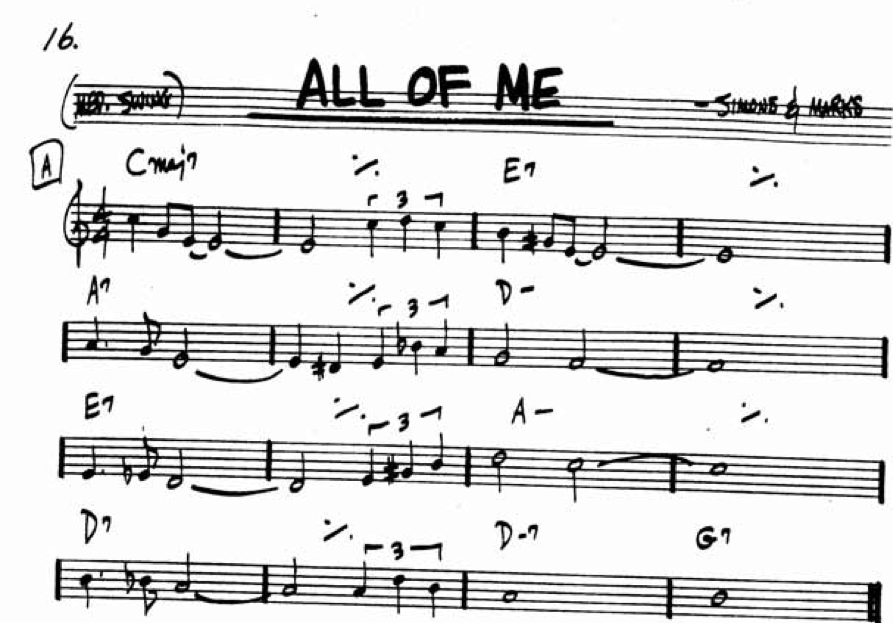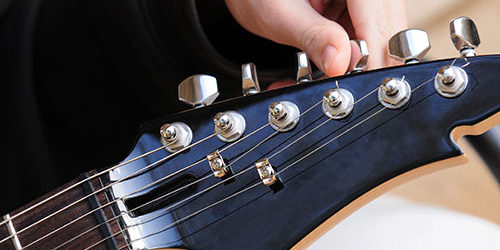
As we learn to play in the various styles and genres of music, it is crucial to become familiar with the repertoire of that genre—and jazz is no different. The term ‘Jazz Standard’ is thrown around a lot between improvising jazz musicians, and we all make it our goal to master as many as possible. The beautiful thing about jazz repertoire is that wherever you are in the world, regardless of language barriers or cultural differences, there are certain jazz standards that other people will know. Right now, the best thing we can do to start our journey into jazz and improvisation is to learn our first tune! When learning a standard on guitar, I like to break each piece down into three equally important parts.
This three-part learning process includes playing the melody by studying the original recordings and developing your own phrasing and interpretation, playing an accompaniment role in the tune which requires thorough knowledge of the harmony and chord structure, and—of course—lastly learning to improvise over these chord changes. So let’s break down the popular Jazz Standard “All of Me” into these three sections: melody, comping, and improvising.
1. The Melody
The melody is the most important part of learning the tune; it is what makes each tune unique. Learning the melody correctly and with great phrasing will help you develop as a strong jazz musician.
Looking at the first four bars of “All of Me,” we see two phrases that are very similar. The first phrase spells a C major triad, descending from the root and landing on the 3rd. The second is an E major triad descending from the 5th and landing on the root. This variation on a phrase is very effective in creating catchy melodies.

In the next line we see a similar phrase, but using an A7 arpeggio; notice how these arpeggios are showing up regularly throughout the tune. At this stage, play the melody using the exact rhythm written from the chart.

Notice how the whole song is built of similar rhythmic phrases. These arpeggios and rhythmic patterns are what makes the melody so strong. The chart below shows the entire song with fingerings shown in tab, learn it note-for-note and then try playing around with the rhythm to give freedom to your phrases.
2. Comping
Comping is a term in jazz referring to accompaniment or playing the harmony under a soloist. As guitarists, comping is important because we will often be playing this role when performing with a singer, saxophone, or any other melodic instrument. In order to 'comp’ effectively, we need to have an understanding of the chord structure of the tune.
Using the barre chords we have learned in previous lessons, we can cover this entire song. The first 4 bars contain a C major chord and an E7 chord. The C will be found on the third fret and the E7 on the seventh fret. When first learning to comp on this tune, we will use the 'Freddie Green’ rhythm, this means playing quarter notes on every beat—also known as 'four to the bar.’ The following chart shows just the chord changes.

Learn with LPM
After playing ‘four to the bar’ through the whole song and after you are feeling comfortable with the chord changes, we can start to expand on the rhythmic ideas with the use of syncopation and adding space. Below are three rhythmic ideas over a bar. Take each one bar rhythm and play it through the whole tune—changing only the chords and keeping this rhythm going.


After you have tried each of these three rhythms individually, mix them up. Try putting rhythm A twice, followed by rhythm, B or vice versa. This will help to develop your rhythmic vocabulary and spice up your comping.
2. Improvisation
Improvisation is likely the most difficult part of learning a tune as you need to be thinking about the chords and be creative, while composing in real time. For this tune, we will look at improvisational tools: the arpeggios and the C major scale. The song is in the key of C, so most of the melody is based around the scale, although there are certain chords (usually dominant chords that go ‘out’ of the scale so we need to be aware of these points).
Looking at the key of C major we have these chords
CM7 Dm7 Em7 FM7 G7 Am7 Bm7b5
So whenever you see these chords, the tune is diatonic to C major, meaning it stays within the notes of the C major scale. The ‘out’ chords or non-diatonic chords will be E7, A7, D7, and the Fm. So in order to outline these chords, we will use the arpeggio. This works nicely as it ends up being mostly two bars of scale and then two bars of arpeggio. Here is an example from the first line, a C major scale over the C chord and an E7 arpeggio over the E7 chord.

Notice how the G# changes to match the E7, this is crucial to outlining the harmony. Try this through the whole tune, playing the scale over the diatonic chords and the arpeggio over the non-diatonic chords. Remember to experiment with the notes of the major scale, some notes will sound better than others.
Although a stylistic choice, it is often common practice to build improvisation around the melody, particularly with older, more melodic standards like “All of Me.” This gives your improvisation context and allows for melodic development and can be much more relatable to the audience. Try playing the melody and using the framework we have gathered from the scale and arpeggios to elaborate upon the melody, it can be as simple as adding a few notes or changing up the rhythm
Example:
The final technique we will look at is the use of a rhythmic motif. For this tune we are going to take the first three-note phrase and continue it through the whole song, changing it to match the arpeggio needed. Here is an example over the first four bars, using the rhythmic motif but starting on a different note.
Original melody phrase

Same rhythmic phrase but starting from the 5th of the arpeggio

Same rhythmic phrase but starting from the 3rd of the arpeggio

Conclusion
All we are doing exploring the different notes of the arpeggio, try this through the whole tune playing each arpeggio using this rhythmic motif. The development of improvisation comes from a thorough understanding and internalization of the melody and harmony. The more techniques we know, the more we have to pull from in the moment, resulting in a more interesting and unique improvisation.
There are so many aspects of improvisation that we could probably spend a lifetime exploring just this tune. Because of this, it’s important to take the time to focus on one area, if you find a phrase that you like better than the one in the melody, use that! See if you can take it through the whole tune without going outside the harmony, this will give it your own twist. Keep exploring the melodic possibilities of the C major scale on this tune, its mostly diatonic so you can really use it extensively.
Learning tunes is the lifelong journey of a jazz musician, there are hundreds if not thousands of jazz ‘standards’ out there to be learnt. One of the best things we can do to be aware of that is to listen to as much music as we can, explore new artists, but don’t be afraid to focus on one artist that really connects with you. When we genuinely love something, we often learn the most and the easiest. All the techniques in this article can be used on any jazz standard, the next step will be to explore more the foundations of more techniques that make up jazz and improvisation before we start to focus on specific areas.
More About the Teacher
Rowan Pattison is an Australian jazz and contemporary guitarist. His resumé boasts artists such as American singer Bobby Arvon (Happy Days), Broadway star Michelle Murlin, American Idol finalist Lou Gazzara, Marcus Terrel from America’s Got Talent, Vegas Trumpet prodigy Greg Bohnam and American Comedian James Stevens III, who is featured regularly on The Tonight Show and Comedy Central. Now based in Melbourne, Rowan has just lead his own trio concert Impressionism of Bill Evans on a tour of Europe playing concerts in Kyiv, Lviv, Krakow and Paris. Rowan's guitar courses with Liberty Park Music include the Introduction to Jazz Improvisation and Introduction to Solo Guitar.







